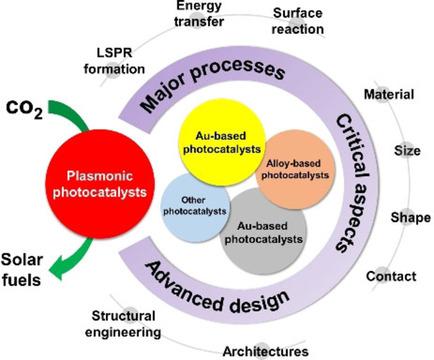当前位置:
X-MOL 学术
›
ChemSusChem
›
论文详情
Our official English website, www.x-mol.net, welcomes your
feedback! (Note: you will need to create a separate account there.)
Plasmonic Photocatalysts for Sunlight-Driven Reduction of CO2 : Details, Developments, and Perspectives.
ChemSusChem ( IF 7.5 ) Pub Date : 2020-05-31 , DOI: 10.1002/cssc.202000905 Nhu-Nang Vu 1 , Serge Kaliaguine 1 , Trong-On Do 1
ChemSusChem ( IF 7.5 ) Pub Date : 2020-05-31 , DOI: 10.1002/cssc.202000905 Nhu-Nang Vu 1 , Serge Kaliaguine 1 , Trong-On Do 1
Affiliation

|
Plasmonic photocatalysis is among the most efficient processes for the photoreduction of CO2 into valuable fuels. The formation of localized surface plasmon resonance (LSPR), energy transfer, and surface reaction are the significant steps in this process. LSPR plays an essential role in the performance of plasmonic photocatalysts as it promotes an excellent, light absorption over a broad wavelength range while simultaneously facilitating an efficient energy transfer to semiconductors. The LSPR transfers energy to a semiconductor through various mechanisms, which have both advantages and disadvantages. This work points out four critical features for plasmonic photocatalyst design, that is, plasmonic materials, size, shape of plasmonic nanoparticles (PNPs), and the contact between PNPs and semiconductor. Various developed plasmonic photocatalysts, as well as their photocatalytic performance in CO2 photoreduction, are reviewed and discussed. Finally, perspectives of advanced architectures and structural engineering for plasmonic photocatalyst design are put forward with high expectations to achieve an efficient CO2 photoreduction shortly.
中文翻译:

等离子光催化剂用于阳光驱动的二氧化碳减排:详细信息,进展和观点。
等离子体光催化是用于CO 2光还原的最有效方法之一转化为有价值的燃料。局部表面等离振子共振(LSPR)的形成,能量转移和表面反应是该过程中的重要步骤。LSPR在等离激元光催化剂的性能中起着至关重要的作用,因为它可在宽波长范围内促进出色的光吸收,同时促进向半导体的有效能量转移。LSPR通过各种机制将能量传输到半导体,这既有优点也有缺点。这项工作指出了等离子光催化剂设计的四个关键特征,即等离子材料,大小,等离子纳米颗粒(PNP)的形状以及PNP与半导体之间的接触。各种发达的等离激元光催化剂及其在CO 2中的光催化性能光还原,进行了审查和讨论。最后,提出了对等离激元光催化剂设计的高级体系结构和结构工程的观点,并期望在不久的将来实现高效的CO 2光还原。
更新日期:2020-05-31
中文翻译:

等离子光催化剂用于阳光驱动的二氧化碳减排:详细信息,进展和观点。
等离子体光催化是用于CO 2光还原的最有效方法之一转化为有价值的燃料。局部表面等离振子共振(LSPR)的形成,能量转移和表面反应是该过程中的重要步骤。LSPR在等离激元光催化剂的性能中起着至关重要的作用,因为它可在宽波长范围内促进出色的光吸收,同时促进向半导体的有效能量转移。LSPR通过各种机制将能量传输到半导体,这既有优点也有缺点。这项工作指出了等离子光催化剂设计的四个关键特征,即等离子材料,大小,等离子纳米颗粒(PNP)的形状以及PNP与半导体之间的接触。各种发达的等离激元光催化剂及其在CO 2中的光催化性能光还原,进行了审查和讨论。最后,提出了对等离激元光催化剂设计的高级体系结构和结构工程的观点,并期望在不久的将来实现高效的CO 2光还原。









































 京公网安备 11010802027423号
京公网安备 11010802027423号